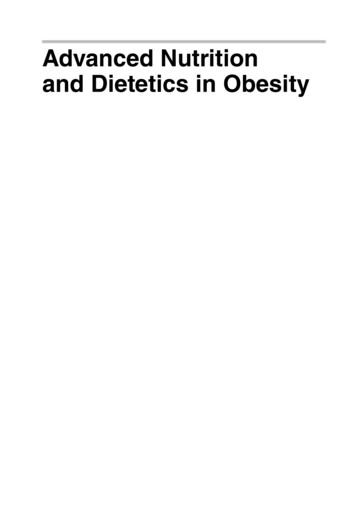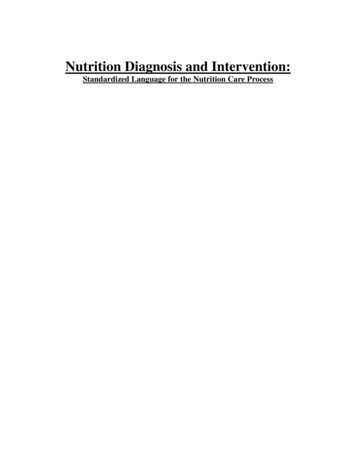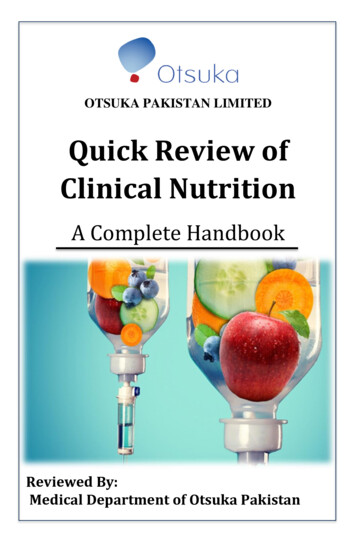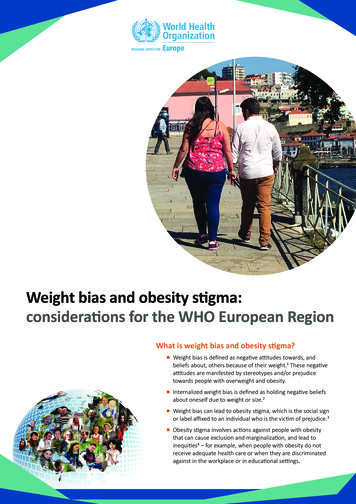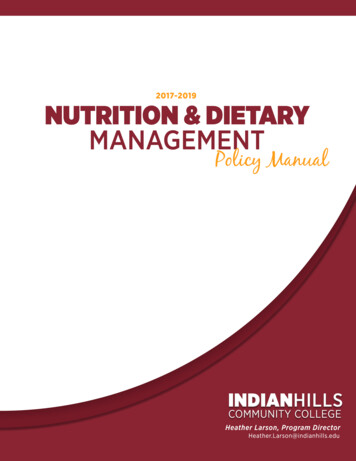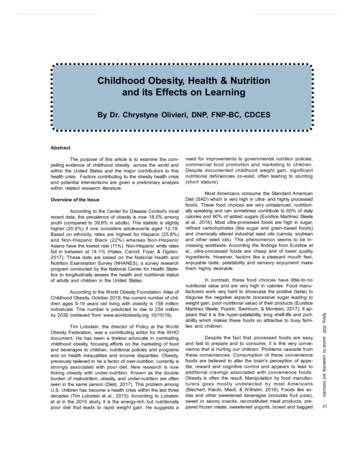
Transcription
Childhood Obesity, Health & Nutritionand its Effects on LearningBy Dr. Chrystyne Olivieri, DNP, FNP-BC, CDCESAbstractThe purpose of this article is to examine the compelling evidence of childhood obesity across the world andwithin the United States and the major contributors to thishealth crisis. Factors contributing to the obesity health crisisand potential interventions are given a preliminary analysiswithin related research literature.Overview of the IssueAccording to the Center for Disease Control's mostrecent data, the prevalence of obesity is now 18.5% amongyouth (compared to 39.8% in adults). This statistic is slightlyhigher (20.6%) if one considers adolescents aged 12-19.Based on ethnicity, rates are highest for Hispanic (25.8%)and Non-Hispanic Black (22%) whereas Non-HispanicAsians have the lowest rate (11%). Non-Hispanic white ratesfall in between at 14.1% (Hales, Carroll, Fryar, & Ogden,2017). These data are based on the National Health andNutrition Examination Survey (NHANES), a survey researchprogram conducted by the National Center for Health Statistics to longitudinally assess the health and nutritional statusof adults and children in the United States.Tim Lobstein, the director of Policy at the WorldObesity Federation, was a contributing editor for this WHOdocument. He has been a tireless advocate in combatingchildhood obesity, focusing efforts on the marketing of foodand beverages to children, nutritional policies and programsand on health inequalities and income disparities. Obesity,previously believed to be a factor of over-nutrition, currently isstrongly associated with poor diet. New research is nowlinking obesity with under-nutrition. Known as the doubleburden of malnutrition, obesity, and under-nutrition are oftenseen in the same person (Dietz, 2017). This problem amongU.S. children has become a health crisis within the last threedecades (Tim Lobstein et al., 2015). According to Lobsteinet al in the 2015 study, it is the energy-rich but nutritionallypoor diet that leads to rapid weight gain. He suggests aSCOPE-JLI-Vol19-1-Spring 2020.pdf 31Most Americans consume the Standard AmericanDiet (SAD) which is very high in ultra- and highly processedfoods. These food choices are very unbalanced, nutritionally speaking and can sometimes contribute to 60% of dailycalories and 90% of added sugars (Eurídice Martínez Steeleet al., 2016). Most ultra-processed foods are high in sugar,refined carbohydrates (like sugar and grain-based foods)and chemically altered industrial seed oils (canola, soybeanand other seed oils). This phenomenon seems to be increasing worldwide. According the findings from Euridice etal., ultra-processed foods are cheap and of lower qualityingredients. However, factors like a pleasant mouth feel,enjoyable taste, palatability and sensory enjoyment makethem highly desirable.In contrast, these food choices have little-to-nonutritional value and are very high in calories. Food manufacturers work very hard to showcase the positive (taste) todisguise the negative aspects (excessive sugar leading toweight gain, poor nutritional value) of their products (EuridiceMartínez Steele, Popkin, Swinburn, & Monteiro, 2017). It appears that it is the hyper-palatability, long shelf-life and portability which makes these foods so attractive to busy families and children.Despite the fact that processed foods are easyand fast to prepare and to consume, it is this very convenience that is hurting our children. Problems cascade fromthese conveniences. Consumption of these conveniencefoods are believed to alter the brain's perception of appetite, reward and cognitive control and appears to lead toadditional cravings associated with convenience foods.Obesity is often the result. Manipulation by food manufacturers goes mostly undetected by most Americans(Blechert, Klackl, Miedl, & W ilhelm, 2016). Foods like sodas and other sweetened beverages (includes fruit juice),sweet or savory snacks, reconstituted meat products, prepared frozen meals, sweetened yogurts, boxed and baggedSpring, 2020 Journal for Leadership and InstructionAccording to the World Obesity Foundation: Atlas ofChildhood Obesity, October 2019, the current number of children ages 5-19 years old living with obesity is 158 millionindividuals. This number is predicted to rise to 254 millionby 2030 (retrieved from www.worldobesity.org 10/15/19).need for improvements to governmental nutrition policies,commercial food promotion and marketing to children.Despite documented childhood weight gain, significantnutritional deficiencies co-exist, often leading to stunting(short stature).314/18/20 10:52 AM
foods like chips, pretzels, cookies, crackers and cereals allfall into this category. Mostly all of these food choices aremade with artificial ingredients (sweeteners, flavors and colors) as well as with highly oxidizable fats like seed oils andtrans-fats. They are also poor sources of healthy fats, protein and fiber as well as of important micronutrients likepotassium, iron, calcium and magnesium.Efforts to try to achieve improved food fortificationthrough enrichment have failed miserably. Lobstein et al participated in a study in conjunction with the World ObesityFederation, (2019) asserting that reducing the obesity rates(and associated under-nutrition) targets for 2025 are likelyto fail. He warns those in the medical field to expect an increase in significant obesity linked health problems, especially in children (T. Lobstein & Jackson-Leach, 2016).Health Effects associated with ObesityHealth problems traditionally only seen in the adultpopulation like hypertension are increasingly found in children (Samuels, Bell, Samuel, & Swinford, 2015). They areoften associated with obesity. Type 2 Diabetes (T2DM), adangerous metabolic disease previously only diagnosed inadulthood, is now often found common in children and adolescents. The development of T2DM in youth is particularlydangerous for the cognitive abilities of our young people, butalso for their overall health.Spring, 2020Journal for Leadership and InstructionA study by M. Constantino, et al. on the relationshipof T2DM diagnosed in youth comparing complication riskand mortality, found that the progression of complications(kidney disease and neuropathy) occurred faster and moreaggressively than in adults (Al-Saeed et al., 2016).Constantino first identified this problem in a prior study aboutthe dangers of T2DM in youth compared to type 1 diabetesand found T2DM to be the far more aggressive type of diabetes (Constantino et al., 2013).32"Treatment Options for T2DM in Adolescents andYouth" (the TODAY study), a large-scale study from 2007,examined the benefits of intensive and sustained lifestyleinterventions to children from mainly racial/ethnic minoritieswith T2DM. It found that despite good glycemic control (bloodsugar control), the metabolic abnormalities of abdominaladiposity, hyperlipidemia, hypertension and early kidney disease were not ameliorated (Zeitler, P., Epstein, L., Grey, M.,Hirst, K., Kaufman, F., Tamborlane, W., & Wilfley, D. (2007). A2013 follow up study on TODAY found that hypertension andearly kidney disease progresses despite adequate glycemic control (Lynch, J., Elghormli, L., Fisher, L., Gidding, S. S.,Laffel, L., Libman, I., Pyle, L., Tamborlane, W. V., Tollefsen, S.,Weinstock, R. S., & Zeitler, P. (2013). Glycemic control is achievable by using pharmaceuticals however their use is limitedin the pediatric population compared to their use in adults.This study suggests that lifestyle interventions (improvingdiet and increasing daily activities) to gain glycemic controlwill help preserve the health and cognitive function of ouryoung people. Merely achieving glycemic control with pharmaceuticals only addresses the symptom of the problem.SCOPE-JLI-Vol19-1-Spring 2020.pdf 32The cause of the problem, rooted in poor food choices, toolittle physical activity and subsequent obesity must be addressed to adequately improve health outcomes.In addition, poor childhood nutrition is associatedwith increased risk of health problems when entering adulthood (Banfield, Liu, Davis, Chang, & Frazier-Wood, 2016).Poor dietary patterns that start in infancy, can also be associated with poor learning and cognitive abilities later in life.Poor school performance and low academic achievementhave been linked to overconsumption of high energy foodsand excess body mass (obesity) (Pearce, Scalzi, Lynch, &Smithers, 2016). This Australian study found that childrenwho are obese in their first year of school may be exhibitinga lower level of cognition compared to their healthy weightpeers. This phenomenon is believed to be evolutionary.A 2019 paper in Trends in Cognitive Sciencesauthored by Mark Mattson discussed how it is not consistentwith our DNA to overconsume on dietary energy (mainly sugarand carbohydrates) with little energy output (daily activity).However, that pattern appears to be very consistent withmodern human lifestyles. Over several million years, humans have evolved specific eating patterns with frequentperiods of food scarcity, that is not consistent with the currentparadigm of eating "three meals a day."An overconsumption of calories when eating theSAD is inconsistent with a frequent human evolutionarymetabolic state known as "ketosis". Ketosis is a metabolicswitch in energy utilization from sugar to fat, which cannothappen when consuming a diet high in sugar and carbohydrates and eating three or more times a day. Mattson concludes that chronic excessive energy intake is associatedwith impaired cognition. Specifically children's excessive abdominal adiposity in children associated with insulin resistance is the driving force in impaired cognitive function, pooreracademic and occupational achievement compared to normal weight classmates (Mattson, 2019). This state of excessive abdominal adiposity in children leads to type 2 diabetes(T2DM) in youth; a more dangerous metabolic state for children than for adults since childhood, a progressive and dynamic stage of human development, is highly sensitive tonutritional needs. This condition profoundly affects cognitivedevelopment as well as physical growth.Brain Development and Cognition in YouthEvidence suggests that improving brain development in our children should be of utmost priority. In a studyin 2016 "The Role of Nutrition in Brain Development",Cusick and Georgieff identified that children's diets oftenmirror their parents (Cusick & Georgieff, 2016). Poor parental food habits are passed on to their children. Thelong-term consequences of poor nutrition (from gestationthrough toddlerhood) and subsequent poor cognitive performance will cost society profoundly. They identify poorquality protein, low intake of healthy fats and poor intake of important micronutrients (iron, zinc and iodine)in the SAD to be contributing factors (see Table 1).4/18/20 10:52 AM
Table 1Common Nutritional Deficiencies associated with SAD**MicronutrientIRONEssential For:Dietary SourcesSpecial Notes:Necessary for oxygentransport inHemoglobin – redblood cellsHeme-Iron: Well-absorbed byhumansIron supplementation is essential inVegans and Vegetarians. Manycommon iron supplementsassociated with constipation anddark stoolsPrevents AnemiaAnimal Products:Red Meats, Organ Meats,Seafood and ShellfishNon-Heme-Iron: Not wellabsorbed by humansVitamin C enhances iron absorptionSpinach, Kale, Collard GreensLegumes (beans, lentils)Critical for fetal andbrain developmentIODINEVitamin AEssential for properreasoning and overallcognitive function inyouthWild-caught seafoodSeaweedEggsEssential for eyesightand immune functionAssociated with foods high inBeta-Carotene:Supports cellulargrowth and celldifferentiationCarrotsSweet Potatoes & YamsIodine supplementation is essentialin Vegans and Vegetarians.Also recommended for generalpopulation if not obtained fromdietary sources to support healthythyroid functionPrior attempts to fortify foods havenot adequately reduced vitamin Adeficiency problems world-wide mainly due to poor absorptionissuesWinter SquashSpinach, Kale, Collard GreensImmunity andresistance to infectionZINCProper neurologicalgrowth, proteinsynthesis and celldivisionAnimal products:Meats and EggsMain ingredient in many coldlozenges. To be taken at first onsetof common cold symptomsShellfishLegumesNuts & Seeds(Vitamin B9)Adequate levelsknown to reduce fetalneural tube defectsLiver and Organ MeatsLegumesAsparagusSpinach ArtichokesFolate supplements VASTLY differfrom Folic Acids supplements.Folate is best obtained from ahealthy diet, but folate supplementsmay be absorbed adequatelyFolic Acid is synthetic and manyconsider toxic – not recommendedNecessary foradequate red bloodcell production** Obtaining these necessary micronutrients from “enriched” grain products (like breads, crackers, pasta, noodles andother sources like legumes) are not absorbed well in the human gastrointestinal tract due to high levels of naturallyoccurring phytates. Therefore, the bioavailability of these essential micronutrients from these sources will be lowerthan from other sources like animal products and vegetables.Spring, 2020 Journal for Leadership and InstructionFOLATEEssential for fetalneurologicaldevelopment (brain,spinal cord, nerves)33SCOPE-JLI-Vol19-1-Spring 2020.pdf 334/18/20 10:52 AM
Chronic undernutrition including iron and iodine deficiencies have been found to further contribute to poor childbrain and n euro logical developm ent (GranthamMcGregor, Fernald, Kagawa, & Walker, 2014). This studyfound that children benefited from nutritional interventionsincluding supplementation for both their development andnutritional status.This problem is noted to begin in infancy as nutrition is important for cognitive development starting from thebeginning of life. Brain development is enhanced from earlychildhood, having long-term effects on cognitive performancethrough adolescence (Nyaradi, Oddy, Hickling, Li, & Foster,2015). Poor quality foods, processed foods, fast foods, highcarbohydrate and sugary foods are not associated with ahealthy brain. Healthy fats have been extensively studied tobe associated with overall health and brain and neurological development (Gershuni, 2018). However, the rapidly developing brain during adolescence is particularly vulnerableto poor nutrition and it is this time of life that requires themost nutritious foods for adequate brain development(Reichelt & Rank, 2017).Spring, 2020Journal for Leadership and InstructionUnhealthful dietary patterns were found to be associated with poorer academic achievement in an independent study done in 2019 (Bleiweiss-Sande et al., 2019). Theresearchers used a diverse sample of over 860 childrenobtained from 3rd and 4th grade in an urban school in theBoston area. W hen unhealthful foods like sweet snacks,salty snacks sweetened beverages and even fruit were highlyconsumed, math and English standardized test scores werelower compared to controls. They were surprised to find fruitto be associated similar to other sweet foods. This was notexpected since fruit is generally considered to be a healthyfood, although it may be overconsumed by children. Basedon these findings, it may be assumed that dietary changesmay positively influence child academic achievement anddevelopment.34In a systemic review from 2013, both math and language learning were found enhanced by both physical activity and improved nutrition among school age children. Theimplementations of school health promotion interventionswas encouraged (Pucher, Boot, & De Vries, 2013). A studydone on Korean children found that diet impacts cognitionand learning in profound ways. Kim & Kang found a linkbetween overconsumption of carbohydrates, specificallynoodles, white rice and ramyeon (Korean instant noodle)and impairment of verbal memory, test scores and reasoning. It also found increases in inattention and impulsivity. Their study also found that the consumption of fastfood and Coca-Cola was related to poor cognitive function, especially working memory, test scores and reasoning (Kim & Kang, 2017).It is not just school work that suffers for obese andmalnourished children, but also behavior issues. There isevidence that obese children have more behavior problemsthan non-obese children (Carey, Singh, Brown III, &Wilkinson, 2015). These researchers cited internalizing prob-SCOPE-JLI-Vol19-1-Spring 2020.pdf 34lems (low self-esteem, sadness, acting withdrawn) and externalizing problems (arguing, fighting, disobedience) alongwith school disciplinary problems (detentions and suspensions) more prevalent among obese children.In light of the SAD in the U.S., Florence et al founda strong association between childhood overweight, underlying poor dietary habits and poor school performance(Florence, Asbridge, & Veugelers, 2008). Their findingssuggest enhanced learning as an additional benefit of ahealthy childhood diet. They also identified overweightchildren to have lower levels of academic achievement.Their findings affirmed that it was not specifically theweight of the child, but the poor nutrition associated withbeing overweight that was the problem. Overall, the dailyintake of healthy foods will have the most impact on improving cognitive function in youth. Their suggestions callfor improvement of school nutrition programs that alsohave potential to improve student's academic performance.Since this study was conducted in 2008, many schoolshave already started to implement nutritional improvementprograms.How Can Schools and the Government Help?In a study conducted in Oregon in 2015, teacherswere asked how to incorporate nutritional knowledge intocurrent curriculum. Most teachers reported that currentapproaches to nutritional education during childhood andadolescence have been largely ineffective in changingcurrent students' food choices. They cited barriers tochange to be: competing academic expectations, lack ofsuitable curricula and food environment at school andhome that does not support what is taught in class (Perera,Frei, Frei, W ong, & Bobe, 2015).Despite these difficulties, schools in the U.S. arethe ideal setting to implement interventions to promotenutrition and physical activity. One such school district inChicago decided to implement their own experiential learning program to incorporate hands-on cooking for studentsto improve nutrition knowledge (Jarpe-Ratner, Folkens,Sharma, Daro, & Edens, 2016). This 10-week after-schoolcooking and nutrition course was taught at each of the 17schools using professional chefs. Chefs completed astandardized training and were issued a curriculum upontraining completion. The curricula were reviewed by a registered dietician and related to the premise that a homefood environment high in accessibility of vegetables andother healthy foods predicts diet quality in children.Parents have a strong influence on the foodchoices made by their children and were included in thetreatment by encouraging them to attend a special presentation. This study, sensitive to cultural food variations,found that it is possible to increase healthy behaviors withina family based on an experiential cooking and nutritioneducation program. According to their findings, althoughbehavior change is not easy, children's exposure to newfoods, different ways to prepare them and the positive4/18/20 10:52 AM
Table 2Natural Diet Guide to Avoid Obesity and Disease:GOGreenEnjoy Daily!CarbohydratesFatsProteinNon-starchy Vegetables:SFA*: Coconut oil, palmkernel oils, grass-fedbutter, ghee, fatty fish*,eggs, dark chocolateAnimal Sources:Like artichokes, asparagus, beets, Brusselssprouts, broccoli, carrots, cauliflower, celery,cucumber, eggplant, green beans, leafygreens*, jicama, leeks, mushrooms, okra,onions, peppers, radishes, snap peas, sprouts,summer squash, spaghetti squash, tomato,turnips, zucchiniEat fruit in-season:Like blueberries, blackberries, strawberries,raspberries are best. Other low sugar fruitsinclude pears, apples, peaches, lemons, limes,oranges, grapefruit, avocado, green bananasMUFA*s: Olives, olive oil,avocado, avocado oilPUFA*: Flax, leafy greens*,fatty fish*, chia seedsSome full-fat dairy (plainyogurt, cheese)Grass-fed* andorganically raisedmeats, wild-gamemeats*, pastureraised poultry, wildcaught fish,seafood, pastureraised eggs, liver,organ meats,unprocessed baconVegetable Sources:Nuts*, seedsFermented vegetables; sauerkraut, KimchiCAUTIONYellowStarchy Vegetables:Like beans and lentils (legumes) corn, peas,white potatoes, parsnips, plantains, sweetpotatoes, taro, winter squash*, yams, yuccaFlaxseed and hempseedoilsFactory raised,grain-fed beef,lamb, pork, poultryMost farm-raisedfishEat on RareOccasionsFactory raisedeggsQuinoa, Buckwheat, Wild RiceLegumes, beanslentils, peanutsAvoid fruit out of Season: most too high insugar content for all year consumptionFermented soyRarely eat melons and tropical fruit (ripebananas, pineapple, papaya) - high in sugarSTOPRedChemically-Altered Oils:Anything from a bag, box, bottle, package andmost cans. Includes Pizza and most take-out &convenience foodsCanola, soybean,sunflower, safflower, corn,cottonseed, grapeseed,peanut oilsGrains & Grain Products;Like wheat, rice, corn, oats, rye, millet, bulgur,amaranth, barley, farro, triticale, teff, speltThis includes bread, cereal, pasta, noodles,crackers, cookies, muffins, cake, garinesHighly processedmeats (hot dogs,bacon, ham,corned beef,pastrami, salami)made withchemicals, driedmeats, deli meats,chicken nuggetsUnfermented soyLow-fat & non-fat dairy(yogurt, cheese)Sweets:Like soda, fruit juice, candy, sweetenedyogurts, ice cream, cake, cookies*Fatty Fish – Include mackerel, salmon, anchovies, sardines, tuna, herring, squid, shellfish; Grass-fed meats – Beef, Lamb,Pork, Bison; Leafy greens – Include beet greens, cabbage, collards, dandelion, endive, kale, lettuce, parsley, spinach, Swisschard, turnip greens, micro-greens, watercress; MUFA – Monounsaturated Fatty Acids; PUFA – Polyunsaturated Fatty Acids;Tree nuts – macadamia, walnuts, coconut, pecans, almonds, pistachios, hazelnuts, brazil nuts; SFA – Saturated Fatty Acids;W ild-game meats – Include venison, rabbit, pheasant, wild duck, bison, elk, caribou, wild boar; W inter squash – Acorn,Butternut, PumpkinSpring, 2020 Journal for Leadership and InstructionRarely, ifever, eatthesedangerous,nutritionallypoor & highlyinflammatoryfoodsProcessed, Prepackaged & Fast-Foods:35SCOPE-JLI-Vol19-1-Spring 2020.pdf 354/18/20 10:52 AM
social aspects associated with these activities can havea profound effect in changing the current situation of obesechildren and their families. (see Table 2).Since 1980, the U.S. government became involvedin setting public nutrition recommendations. Dietary guidelines for Americans have been published and updated everyfive years since 1980 in an attempt to guide healthy foodchoices. Unfortunately, this government policy lead by theUnited States Department of Agriculture (USDA) has not ameliorated the obesity epidemic. The U.S. government has alsotried to implement policies to address the obesity problemamong children by focusing on food at school. The USDA alsosponsored the National School Lunch Program which provides nutritionally balanced, free or low-cost meals to millionsof children. However, this is only one part of the solution.Spring, 2020Journal for Leadership and InstructionThe Centers for Disease Control and Preventionprovides recommendations for Coordinated School Healthapproach, coordinating health and physical education aswell as nutrition services into the school environment (Careyet al., 2015). These services are available in schools. However these interventions need to be supported both withinthe community and in the home. Socio-economic inequities, parental education about the importance of nutritionand physical activity may be lacking and could be addressed in a school setting as a community public service. Until nutrition education produces healthier children,parental involvement may be of specific benefit for implementation in a school setting. A structured approach iscrucial to not only improving outcomes in these children,but in preventing long-term costs associated with poorstudent outcomes and future health problems associatedwith a lifetime of obesity and malnutrition.This article outlines compelling evidence for a pervasive problem. Over the last two decades, childhood obesity remains on an upward trajectory for all age groups withobese children often becoming obese adults. The forseablefuture does not seem to currently be turning the tide. Thecontinued increase in childhood obesity is likely to overwhelm the current medical systems in many countriesthroughout the world. There is much more to be done tomitigate obesity, the subsequent health problems, and thecognitive issues that seem to coincide in occur with toomany children. In light of the presented evidence in thisarticle, the cognitive, social and behavioral problems associated with obese children is a problem that will not likelybe solved in the short term without schools becoming moreinvolved with nutrition.ReferencesAl-Saeed, A. H., Constantino, M. I., Molyneaux, L., D'Souza, M.,Limacher-Gisler, F., Luo, C., Wu, T., Twigg, S. M., Yue, D. K., &Wong, J. (2016). An inverse relationship between age of type 2diabetes onset and complication risk and mortality: The impactof youth-onset type 2 diabetes. Diabetes Care, 39(5), 823-829.36SCOPE-JLI-Vol19-1-Spring 2020.pdf 36Banfield, E. C., Liu, Y., Davis, J. S., Chang, S., & FraizerWood, A. C. (2016). Poor adherence to US dietary guidelinesfor children and adolescents in the national health and nutrition examination survey population. Journal of the Academyof Nutrition and Dietetics, 116(1), 21-27.Blechert, J., Klackl, J., Miedl, S. F., & Wilhelm, F. H. (2016). Toeat or not to eat: Effects of food availability on reward systemactivity during food picture viewing. Appetite, 99, 254-261.Bleiweiss-Sande, R., Chui, K., Wright, C., Anzman-Frasca,S., Amin, S., & Sacheck, J. (2019). Associations betweendietary intake patterns, cognition and academic achievementin 3rd and 4th grade children from the fueling learning throughexercise study (P04-096-19). Current Development in Nutrition, 3(Suppl. 1). doi: 10.1093/cdn/nzz051.P04-096-19Carey, F. R., SIngh, G. K., Brown III, H. S., & Wilkinson, A. V.(2015). Educational outcomes associated with childhoodobesity in the United States: Cross-sectional results fromthe 2011-2012 national survey of children's health. International Journal of Behavioral Nutrition and Physical Activity,12(Suppl. 1), S3. doi: 10.1186/1479-5868-12-S1-S3Constantino, M. I., Molyneaux, L., Limacher-Gisler, F., AlSaeed, A., Luo, C., Wu, T., Twigg, S. M., Yue, D. K., & Wong, J.(2013). Long-term complications and mortality in young-onset diabetes: Type 2 diabetes is more hazardous and lethalthan type 1 diabetes. Diabetes Care, 36, 3863-3869.Cusick, S. E., & Georgieff, M. K. (2016). The role of nutrition inbrain development: The golden opportunity of the "first 1000days". The Journal of Pediatrics, 175, 16-21. doi: 10.1016/j.jpeds.2016.05.013Dietz, W. H. (2017). Double-duty solutions for the doubleburden of malnutrition. The Lancet, 390, 2607-2608.Florence, M. D., Asbridge, M., & Veugelers, P. J. (2008). Dietquality and academic performance. Journal of School Health,78(4), 209-215.Gershuni, V. M. (2018). Saturated fat: Part of a healthy diet.Current Nutrition Reports, 7(3), 85-96.Grantham-McGregor, S. M., Fernald, L., Kagawa, R., & Walker,S. (2014). Effects of integrated child development and nutrition interventions on child development and nutritional status.Annals of the New York Academy of Sciences, 1308(1), 11-32.Hales, C. M., Carroll, M. D., Fryar, C. D., & Ogden, C. L. (2017).Prevalence of obesity among adults and youth: United States,2015-2016. NCHS data brief, no 288. Hyattsville, MD: National Center for Health Statistics. 2017.Jarpe-Ratner, E., Folkens, S., Sharma, S., Daro, D., & Edens,N. K. (2016). An experiential cooking and nutrition educationprogram increases cooking self-efficacy and vegetable consumption in children in grades 3-8. Journal of Nutrition Education and Behavior, 48(10), 697-705. doi: 10.1016/j.jneb.2016.07.0214/18/20 10:52 AM
Kim, J. Y., & Kang, S. W. (2017). Relationships between dietary intake and cognitive function in healthy Korean childrenand adolescents. Journal of Lifestyle Medicine, 7(1), 10.activity and nutrition can improve academic performance inprimary- and middle-school children. Health Education,113(5), 372-391.Lobenstein, T., Jackson-Leach, R., Moodie, M. L., Hall, K. D.,Gortmaker, S. L., Swinburn, B. A., James, P. T., Wang, Y., &McPherson, K. (2015). Child and adolescent obesity: Part ofa bigger picture. The Lancet, 385, 2510-2520.Reichelt, A. C., & Rank, M. M. (2017). The impact of junk foods onthe adolescent brain. Birth Defects Research, 109, 1649-1658.Lobestein, T., & Jackson-Leach, R. (2016). Planning for theworst: Estimates of obesity and comorbidities in school-agechildren in 2025. Pediatric Obesity, 11(5), 321-325.Lynch, J., Elghormli, L., Fisher, L., Gidding, S. S., Laffel, L.,Libman, I., Pyle, L., Tamborlane, W. V., Tollefsen, S.,Weinstock, R. S., & Zeitler, P. (2013). Rapid rise in hypertension and nephropathy in youth with type 2 diabetes: TheTODAY clinical trial. Diabetes Care, 36, 1735-1741.Samuels, J., Bell, C., Samuel, J., & Swinford, R. (2015). Management of hypertension in children and adolescents. CurrentCardiology Reports, 17(12). doi: 10.1007/s11886-015-0661-1Steele, E. M., Baraldi, L. G., da Costa Louzada, M. L., Moubarac,J. C., Mozaffarian, D., & Monteirom C. A. (2016). Ultra-processed foods and added sugars in the US diet: Evidencefrom a nationally representative cross-sectional study. BMJOpen, 6(3), e009892. doi: 10.1136/bmjopen-2015-009892.Mattson, M. P. (2019). An evol
little physical activity and subsequent obesity must be ad-dressed to adequately improve health outcomes. In addition, poor childhood nutrition is associated with increased risk of health problems when entering adult-hood (Banfield, Liu, Davis, Chang, & Frazier-Wood, 2016). Poor





